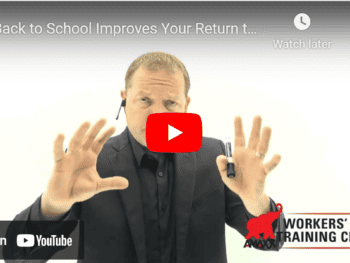
Having the right return-to-work attitude, as well as understanding the various transitional work programs, are the first steps to a successful program.
Alternate or Light Duty Programs
Alternate or light duty programs allow employees to work at less demanding jobs until they are physically able to resume their original work duties. For example, an employee who normally does physically demanding labor could work in a more sedentary capacity, such as answering telephones or taking product inventories.
Click Link to Access Free PDF Download
“13 Research Studies to Prove Value of Return-to-Work Program & Gain Stakeholder Buy-In”
Modified Duty Program
The second type of transitional work program is the modified duty program, where injured employees’ original jobs are modified through engineering alterations of the workstation. Employers use these programs to prevent aggravation of the injury. For example, an employer could install seats with added back supports and footrests to relieve discomfort for an employee with an injured back.
Work Hardening
“Work hardening” is the third type of transitional work program. In these programs, employees perform their usual job-related tasks in steps of increasing difficulty until they regain the physical ability needed to perform their original jobs. This allows the injured employee to remain at work, although at reduced hours. Sometimes, employees in a work hardening program will be placed in a simulated off-site work environment. Here, they perform simulated assignments closely approximating the tasks they perform at their real jobs. Many vendors offer these work simulation programs.
Additional Return to Work Considerations
Transitional work positions can be located in the same or a different department or even in another company or operating division. Some employees perform transitional work program duties in the community as a volunteer in an employer-sponsored volunteer activity or in a commercial vocational rehabilitation return-to-work center. In these instances, employers should provide transportation for the employee to the work facility to demonstrate continued involvement and concern for his or her recovery.
FREE DOWNLOAD: “13 Research Studies to Prove Value of Return-to-Work Program & Gain Stakeholder Buy-In”
During the return-to-work process, companies need to consider the employee’s physical limitations. If injured workers exceed their physical abilities, they may experience a recurrence of the injury, causing unnecessary pain and suffering for the employee and needless additional workers’ compensation costs for their employers. Also, although employers can use transitional work programs for temporary illnesses and injuries, it is important to remember all absence and disability programs must be integrated with the requirements of the Family and Medical Leave Act and the Americans with Disabilities Act.

Author Michael Stack, Principal, COMPClub, Amaxx LLC. He is an expert in workers compensation cost containment systems and helps employers reduce their work comp costs by 20% to 50%. He works as a consultant to large and mid-market clients, is co-author of Your Ultimate Guide To Mastering Workers Comp Costs, a comprehensive step-by-step manual of cost containment strategies based on hands-on field experience, and is founder of COMPClub, an exclusive member training program on workers compensation cost containment best practices. Through these platforms he is in the trenches on a working together with clients to implement and define best practices, which allows him to continuously be at the forefront of innovation and thought leadership in workers’ compensation cost containment. Contact: mstack@reduceyourworkerscomp.com.
©2016 Amaxx LLC. All rights reserved under International Copyright Law.
FREE DOWNLOAD: “13 Research Studies to Prove Value of Return-to-Work Program & Gain Stakeholder Buy-In”
ESSENTIAL: This article is Return-to-Work Essentials content.















 Control Workers Comp Losses To Control Premiums
Control Workers Comp Losses To Control Premiums

Michael, thanks for your thoughtful comments on transitional duty programs. I’d like to add some comments relative to the Modified Duty option. In addition to engineering alterations of the workstation, the job can be modified by allowing co-workers to assist with certain tasks – for example, with lifting some things can be a 2-person lift. I’ve also seen a temporary change in tools or equipment until the employee is back to full duty. For the work hardening option, one advantage to carrying it out in a clinical setting is the ease of performing graded activities compared to attempting gradation in the actual work environment. Particularly when it comes to materials handling and endurance/work tolerance.
In order to effectively implement a transitional duty program, fairly detailed job analysis is critical so that the employer has a clear understanding of the physical demands of the jobs. A return-to-work fitness for duty or functional test can be particularly helpful for objectively determining the employee’s physical abilities and comparing them to the job demands. Not only will the fitness for duty test tell the employer whether this person is ready to return to work, the results of testing can be used to establish program goals and monitor progress. Periodic re-testing and/or repeat testing at the end of the work hardening program can also insure that the employee is ready to return to full duty.